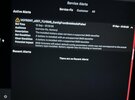Received this message on an 3 week old Model Y after updating to 2023.32.4. Anyone understand what this message means? Is this a low voltage or high voltage batter BMS issue?
Hoping it just needs a low voltage battery swap.
Hoping it just needs a low voltage battery swap.
| Description | The installed battery does not have a supported EMB identifier |
| Bet Condition | A battery is installed with an unsupported BMB identifier |
| Clear Condition | A battery is installed with a supported BMB identifier |
| Potential impact | BMS firmware will select default config parameters which may not correspond to the actual battery type installed, Battery signals may be missing or incorrect |



